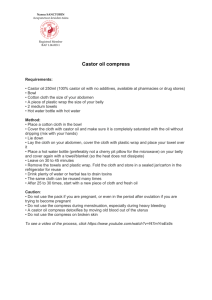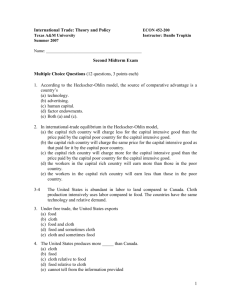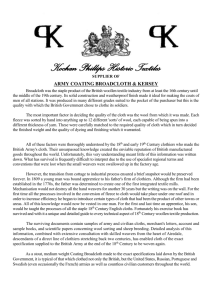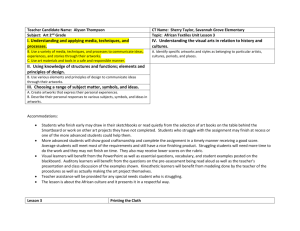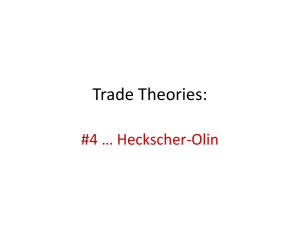Lecture notes 5 September 10 - 12: The Heckscher
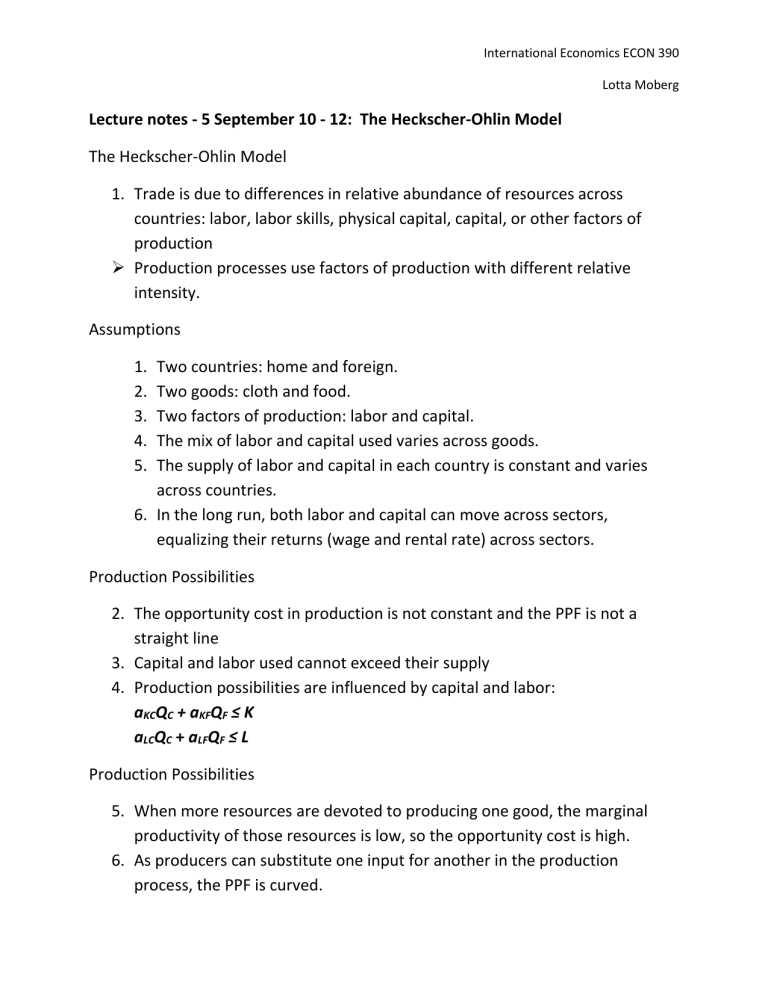
International Economics ECON 390
Lotta Moberg
Lecture notes - 5 September 10 - 12: The Heckscher-Ohlin Model
The Heckscher-Ohlin Model
1.
Trade is due to differences in relative abundance of resources across countries: labor, labor skills, physical capital, capital, or other factors of production
Production processes use factors of production with different relative intensity.
Assumptions
1.
Two countries: home and foreign.
2.
Two goods: cloth and food.
3.
Two factors of production: labor and capital.
4.
The mix of labor and capital used varies across goods.
5.
The supply of labor and capital in each country is constant and varies across countries.
6.
In the long run, both labor and capital can move across sectors, equalizing their returns (wage and rental rate) across sectors.
Production Possibilities
2.
The opportunity cost in production is not constant and the PPF is not a straight line
3.
Capital and labor used cannot exceed their supply
4.
Production possibilities are influenced by capital and labor: a
KC
Q
C
+ a
KF
Q
F
≤ K a
LC
Q
C
+ a
LF
Q
F
≤ L
Production Possibilities
5.
When more resources are devoted to producing one good, the marginal productivity of those resources is low, so the opportunity cost is high.
6.
As producers can substitute one input for another in the production process, the PPF is curved.
International Economics ECON 390
Lotta Moberg
Opportunity cost of cloth increases as producers make more cloth.
7.
The economy produces at the point that maximizes the value of production,
V.
8.
The priceline, or isovalue line, represents a constant value of production, V:
V = P
C
Q
C
+ P
F
Q
F
9.
The slope of the line is: – (P
C
/P
F
)
(Learn to draw the Production Possibility Frontier with Factor Substitution with isovalue lines)
10.
Given the relative price of cloth, the economy produces at the point Q that touches the highest value line, maximizing the value of production.
At that point, the relative price of cloth equals the slope of the PPF, which is the opportunity cost of producing cloth.
The amounts of factors of production producers choose to use depend on the wage, w, and the rental rate, r.
If w increases relative to r, producers use less labor and more capital in the production of both food and cloth.(Learn to illustrate: Input Possibilities in
Food Production; Factor Prices and Input Choices)
At any factor prices, cloth production uses more labor relative to capital than does food production: a
LC
/a
KC
> a
LF
/a
KF
or L
C
/K
C
> L
F
/K
F
Production of cloth is relatively labor intensive, while production of food is relatively land intensive.
Factor Prices and Goods Prices
11.
In competitive markets, the price of a good should equal its cost of production, which depends on the factor prices.
12.
How changes in the wage and rent affect the cost of producing a good depends on the mix of factors used.
International Economics ECON 390
Lotta Moberg
13.
An increase in the rental rate of capital should affect the price of food more than the price of cloth since food is the capital intensive industry.
14.
Changes in w/r are tied to changes in: P
C
/P
W
:
If the relative price of a good increases, then the real wage or rental rate of the factor used intensively in the production of that good increases, while the real wage or rental rate of the other factor decreases. (This is illustrated in the book as the SS curve.)
15.
Therefore, any change in the relative price of goods alters the distribution of income.
16.
An increase in the relative price of cloth, P
C
/P
F
:
raises income of workers relative to that of capital owners, w/r.
raises the ratio of capital to labor services, K/L, used in both industries.
raises the real income (purchasing power) of workers and lower the real income of capital owners.
Resources and Output
17.
Assume an economy’s labor force grows, which implies that its ratio of labor to capital L/K increases.
Expansion of production possibilities is biased toward cloth.
At a given relative price of cloth, the ratio of labor to capital used in both sectors remains constant.
To employ the additional workers, the economy expands production of the relatively labor-intensive good cloth and contracts production of the relatively capital-intensive good food.
If you hold output prices constant as the amount of a factor of production increases, then the supply of the good that uses this factor intensively increases and the supply of the other good decreases. (Learn to illustrate changes in production possibilities when a resource increases or decreases)
18.
An economy with a high ratio of labor to capital produces a high output of cloth relative to food.
International Economics ECON 390
Lotta Moberg
Suppose that Home is relatively abundant in labor and Foreign in capital:
L/K > L*/ K*
Home will be relatively efficient at producing cloth because cloth is relatively labor intensive.
Since cloth is relatively labor intensive, at each relative price of cloth to food, Home will produce a higher ratio of cloth to food than Foreign.
Trade in the Heckscher-Ohlin Model
19.
The countries are assumed to have the same technology and the same tastes.
Comparative advantage then lies in the good that relatively intensively uses the factors of production in which the country is relatively well endowed.
With the same tastes, the two countries will consume cloth to food in the same ratio when faced with the same relative price of cloth under free trade.
Since cloth is relatively labor intensive, at each relative price of cloth to food, Home will produce a higher ratio of cloth to food than Foreign.
20.
As in the Ricardian Model, Trade Leads to a Convergence of Relative Prices:
The relative price of cloth rises in the relatively labor abundant (home) country and falls in the relatively labor scarce (foreign) country.
In Home, the rise in the relative price of cloth leads to a rise in the relative production of cloth and a fall in relative consumption of cloth.
Home becomes an exporter of cloth and an importer of food.
The decline in the relative price of cloth in Foreign makes it an importer of cloth and an exporter of food.
The Heckscher-Ohlin Theorem
21.
An economy has a comparative advantage in producing, and thus will export, goods that are relatively intensive in using its relatively abundant factors of production.
International Economics ECON 390
Lotta Moberg
22.
It will import goods that are relatively intensive in using its relatively scarce factors of production.
Factor Price Equalization
23.
Unlike the Ricardian model, the Heckscher-Ohlin model predicts that factor prices will be equalized among countries that trade.
Free trade equalizes relative output prices.
Due to the connection between output prices and factor prices, factor prices are also equalized.
Trade increases the demand of goods produced by relatively abundant factors, indirectly increasing the demand of these factors, raising the prices of the relatively abundant factors.
24.
In the real world, factor prices are not equal across countries.
Trading countries do often not produce the same goods, if their factor ratios radically differ.
Trading countries do not always have the same technology, which affects the productivities of factors and therefore the wages/rates paid to these factors.
Trade barriers and transportation costs may prevent output prices and thus factor prices from equalizing.
The model predicts outcomes for the long run. After an economy liberalizes trade, factors of production may not quickly move between industries.
Does Trade Increase Income Inequality?
According to the H-O model, wages of unskilled workers should increase in unskilled labor abundant countries relative to wages of skilled labor.
In some cases the reverse has occurred: Wages of skilled labor have increased more rapidly in Mexico than wages of unskilled labor.
Because factor prices are not equalized across countries, the real volume of trade is much smaller than what the model predicts. (The “missing trade”)
The reason for this “missing trade” appears to be the assumption of identical technology among countries.




